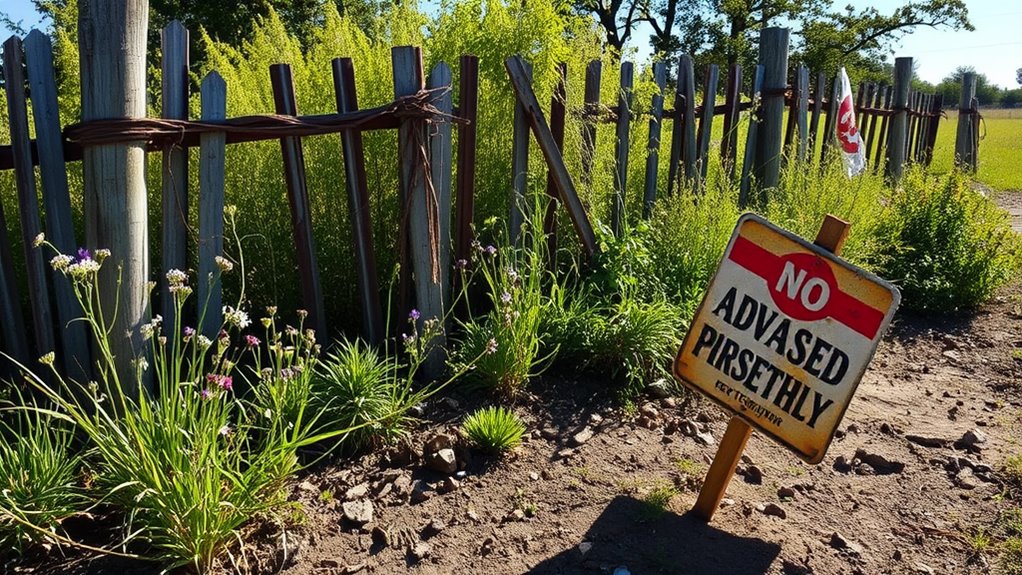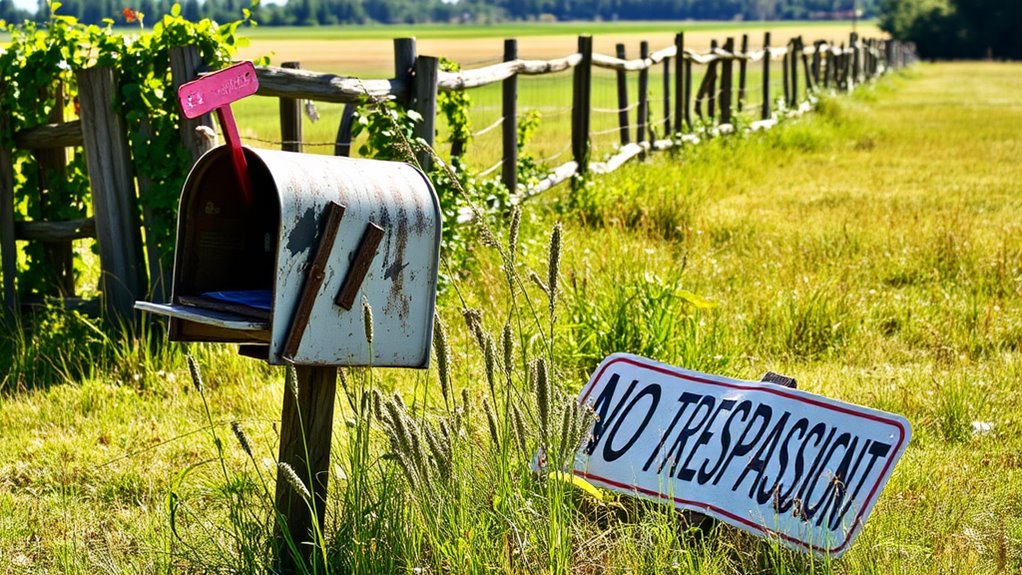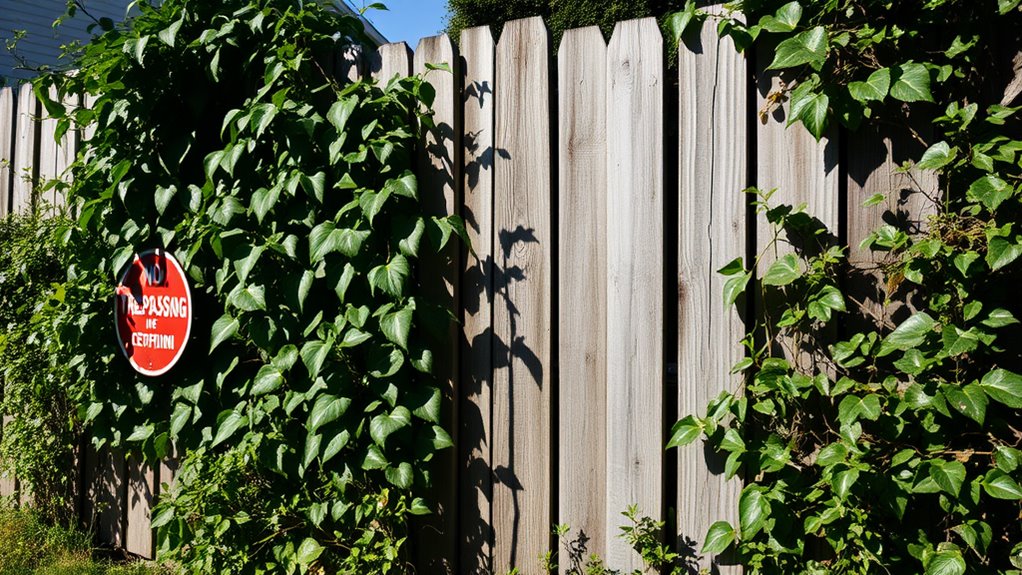Adverse possession is a legal principle that lets you claim ownership of land if you’ve used it openly, exclusively, and continuously for a specific period without the owner’s permission. This doctrine encourages productive land use and resolves disputes over neglected properties. Requirements like hostile possession and statutory timeframes vary by jurisdiction, but factors like visible use and exclusivity are universal. Understanding these elements can help you navigate potential claims and protections more effectively.
Key Takeaways
- Adverse possession allows trespassers to claim ownership through continuous, unauthorized use of land.
- It requires hostile, open, notorious, exclusive, and continuous possession for a statutory period.
- The statutory period varies by jurisdiction, typically ranging from 5 to 20 years.
- Government land and properties with owner consent cannot be claimed under adverse possession.
- Prevent claims by marking boundaries, addressing trespassers, and regularly inspecting the property.
Key Takeaways on Adverse Possession
Adverse possession is a legal doctrine that enables a trespasser to acquire ownership of land through continuous, unauthorized use for a period defined by state law. To succeed, you must meet five essential elements. Your possession must be actual, meaning you physically occupy and use the land as an owner would. It must also be open and notorious, ensuring the use is visible and apparent to the true owner. Your possession must be exclusive; you can’t share control with others, including the owner. Additionally, your use must be hostile, implying it’s without the owner’s permission. Finally, you must maintain these conditions continuously throughout the statutory period, which varies by jurisdiction. Meeting these criteria allows you to claim ownership, provided no permission or rental agreement exists. This doctrine encourages land use efficiency and resolves disputes over neglected properties. Understanding land appreciation can provide insights into how adverse possession affects long-term property values.
Understanding the Concept of Adverse Possession

Ownership disputes often arise when land remains unused or neglected for extended periods. Adverse possession is a legal doctrine that allows a trespasser to claim ownership of property after occupying it continuously for a specified period, typically ranging from 3 to 30 years, depending on jurisdiction. This principle, rooted in early British jurisprudence, aims to resolve conflicts over land that the legal owner has abandoned or failed to maintain. To succeed in an adverse possession claim, you must demonstrate open, notorious, exclusive, hostile, and continuous use of the property. The concept serves to guarantee that land is actively used and maintained, preventing legal titleholders from indefinitely holding unused property. However, it’s vital to understand that adverse possession doesn’t automatically transfer ownership; you must meet specific criteria to establish a valid claim and potentially obtain a new title to the land. Before pursuing such a claim, consulting property line maps can help clarify boundaries and avoid unnecessary disputes.
Legal Requirements for Adverse Possession

To successfully claim adverse possession, you must meet several strict legal requirements established by state law. Adverse possession must include continuous possession, meaning you occupy the property uninterrupted for the full statutory period. Your possession must also be hostile possession, indicating you’re using the property without the owner’s permission. Additionally, your use must be open and notorious possession, making it obvious to the public and the legal owner. You must maintain exclusive possession, ensuring no one else, including the rightful owner, shares control. Failure to satisfy any of these elements can invalidate your claim. The table below outlines the key legal requirements for adverse possession.
| Requirement | Description |
|---|---|
| Continuous Possession | Uninterrupted use of the property for the statutory period. |
| Hostile Possession | Occupation without the owner’s consent or permission. |
| Open & Notorious | Use that’s visible and obvious, providing constructive notice to the owner. |
| Exclusive Possession | Sole control over the property, excluding others, including the legal titleholder. |
| Statutory Period | Timeframe set by state law, typically 5 to 20 years, for continuous occupation. |
Duration and Time Limits by Jurisdiction

The statutory period for adverse possession differs considerably by jurisdiction, with states like California requiring only 5 years and New York mandating 10 years of continuous possession. You’ll find Texas permits a 3-year claim under color of title, while the UK’s Land Registration Act stipulates 10 years before a claim can proceed. These time limitations directly impact the viability of your claim and require careful attention to state-specific requirements.
Statutory Period Variations
While most jurisdictions recognize adverse possession, the statutory periods vary considerably, reflecting diverse legal traditions and policy priorities. In California, you must demonstrate continuous possession for only five years to claim adverse possession, one of the shortest periods in the U.S. New York, however, requires a 10-year period under its real property laws. Texas offers multiple statutory periods, ranging from 3 to 25 years, depending on factors like possession under color of title or payment of taxes. In England, you must occupy unregistered land for 12 years under the Land Registration Act 2002. Washington shortens the period to seven years if you possess color of title. These variations highlight how jurisdictions balance interests in real property with the need for legal action to resolve disputes over land ownership.
State-Specific Requirements
When you claim adverse possession, the duration you must demonstrate varies substantially depending on the jurisdiction. The time limit for adverse possession claims is determined by state-specific requirements, which dictate the period of possession needed to assert ownership. Continuous and uninterrupted possession is essential in all jurisdictions, but the statutory duration differs widely. Below is a table summarizing the requirements for adverse possession in key states:
| State | Period of Possession | Additional Notes |
|---|---|---|
| California | 5 years | One of the shortest time limits |
| New York | 10 years | Moderate statutory duration |
| Texas | 3, 5, 10, or 25 years | Depends on factors like taxes |
| Pennsylvania | 21 years | Longest statutory period |
| Florida | 7 or 20 years | Depends on color of title |
Time Limitations Impact
Understanding state-specific requirements for adverse possession sets the foundation for examining how time limitations impact claims across jurisdictions. Adverse possession requires a continuous and uninterrupted period of occupancy, but the duration varies markedly by location. In California, you must occupy the property for at least five years. New York extends this period to 10 years, while Texas imposes multiple timeframes, including three years, five years, 10 years, or even 25 years, depending on specific conditions. In England, the Land Registration Act 2002 mandates a 10-year period for registered land, whereas pre-2002 claims were governed by a 12-year period under the Limitation Act 1980. These differences emphasize the importance of verifying jurisdictional time limits, as failing to meet the required period can nullify your claim.
Hostile and Continuous Possession Explained

Hostile possession occurs when a trespasser occupies land without the owner’s permission, directly conflicting with the owner’s property rights. To establish hostile possession, the trespasser must assert a claim of right, meaning they use the property as though they own it, regardless of whether they believe they have legal title. This claim doesn’t require ill intent; even a mistaken belief suffices. Continuous possession requires that the trespasser maintains uninterrupted control of the property for the statutory period. This doesn’t mean constant physical presence but rather consistent use of the property in a manner typical for its type, as seen in Howard v Kunto, where seasonal use sufficed. You may also combine periods of possession through “tacking” if successors take over the occupation. Both hostile and continuous possession must be proven to meet legal standards for adverse possession claims.
Open, Notorious, and Exclusive Occupation

Open and notorious occupation requires the adverse possessor’s use of the land to be visible and apparent, giving the true owner and the public clear notice of the claim. This element guarantees that the possession isn’t hidden, allowing the true owner an opportunity to take action against the occupation. Notorious possession serves as constructive notice, meaning the owner is deemed aware, even if they aren’t. Exclusive occupation means the adverse possessor must control the land solely, without sharing possession with the true owner or others. Acts like fencing, cultivating, or building on the property demonstrate open and notorious use, while exclusivity confirms the adverse possessor acts as the sole user.
To understand this element further:
- Visibility: The adverse possessor’s use must be obvious to anyone inspecting the land.
- Notice: The true owner is presumed aware, even without direct knowledge.
- Control: The adverse possessor must exercise dominion over the land.
- Sole Use: Shared possession with the owner or others invalidates exclusivity.
Exclusions and Limitations in Adverse Possession

Though adverse possession allows for the acquisition of property through continuous occupation, certain exclusions and limitations restrict its applicability. You cannot claim adverse possession over land owned by someone if it belongs to the government or is designated as public land, regardless of your occupation. If you’re a tenant under a rental agreement, you’re categorically barred from claiming adverse possession, even if you’ve occupied the property for the statutory period. Consent from the property owner, whether verbal or written, negates the “hostile” element required for a legal claim adverse possession. Additionally, if the true owner acknowledges your use through written agreements or licenses, you lose eligibility. Claims based on forged documents, such as deeds or powers of attorney, are explicitly excluded from adverse possession. These limitations guarantee the doctrine isn’t misapplied and protects rightful ownership. Tenants who attempt to claim adverse possession may face legal consequences as outlined in eviction procedures and tenant rights.
Preventing Adverse Possession Claims

You must clearly mark your property boundaries with visible structures or signage to deter potential adverse possession claims. Address trespassers immediately by issuing warnings or taking legal action to prevent hostile occupation. Regularly inspect your land to guarantee unauthorized use isn’t occurring without your knowledge.
Marking Property Boundaries
Establishing unmistakable boundary indicators is essential to safeguarding property rights and deterring adverse possession claims. Clearly marking your property line with visible fences, walls, or survey markers establishes ownership and prevents encroachments. To guarantee your private property is protected, follow these steps:
- Conduct Land Surveys: Regularly verify property boundaries with a licensed surveyor to create an accurate legal document that defines your property line.
- Install Boundary Markers: Use durable, visible markers like stakes, fences, or walls to physically delineate your property boundaries.
- Post No Trespassing Signs: Place signs along the perimeter to notify others of private property and discourage unauthorized use.
- Maintain Documentation: Keep updated records of land surveys and boundary markers to resolve potential boundary disputes effectively.
Understanding zoning regulations and their impact on permissible land uses can further reinforce your property’s value and prevent adverse possession claims. These measures reduce ambiguity and reinforce your control over the property.
Addressing Trespassers Promptly
To prevent adverse possession claims, it’s critical to address trespassers promptly and assert your ownership rights. Confront and remove unauthorized individuals immediately to disrupt any potential establishment of continuous possession. Serve written notices explicitly prohibiting trespass to confirm their use of the property isn’t interpreted as permissive. Install visible barriers such as fences and “no trespassing” signs to clearly demarcate boundaries and deter encroachment. Document all interactions with trespassers, including dates and actions taken, to create a record that refutes any adverse possession claims. If trespass persists, seek legal action by filing a trespass lawsuit to formally assert your ownership and discourage future violations. Proactive measures are essential to protect your property rights effectively. Additionally, consider offering cash incentives to trespassers to encourage their swift departure and avoid lengthy legal battles.
| Action | Purpose |
|---|---|
| Serve written notices | Prevent claims of permissive use |
| Install visible barriers | Clearly demarcate property ownership |
| Document interactions | Disprove continuous possession claims |
Conclusion
To establish adverse possession, you must meet all legal requirements: hostile, continuous, open, notorious, and exclusive possession for the statutory period—often 10 to 20 years. For example, in *Howard v. Kunto*, the claimants occupied a coastal property openly for years, meeting these criteria, and won the case. To prevent claims, you should monitor your property, mark boundaries, and evict trespassers promptly to safeguard your rights aren’t jeopardized.




